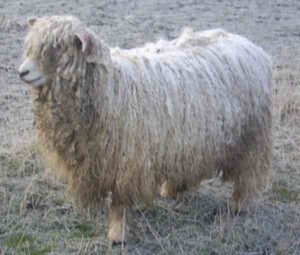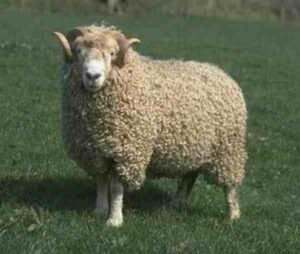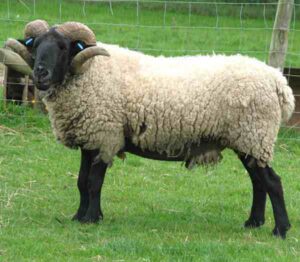The Clun Forest sheep is a multi-purpose breed of domestic sheep from United Kingdom. It was originated from the area surrounding the Clun Forest in Shropshire, England.
Like many other British sheep breeds, these animals are adaptable, very hardy, good foragers and are long-lived.
One of the first mentions of the Clun Forest sheep breed is in 1803, when the Rev. Joseph Plymley, writing on the agriculture of Shropshire for the Board of Agriculture , quoted from a previous report dealing with these forest sheep. He stated that ‘upon the hills nearer Wales the flocks were without horns and had white faces’.
The Clun Forest Sheep Breeders Society was formed in 1925 in Great Britain for securing the purity of lineage and fixity of type.
Aim of the society was also to promote the virtues of the breed throughout the sheep industry.
The Clun Forest sheep flocks began to establish pedigree status gradually, and during the mid forties to the seventies the breed entered it’s Golden Age.
And during this period, the breed became the 3rd most numerous purebred sheep breed in Britain.
Along with availability of the Clun Forest sheep breed in it’s native area, it is also found in some other parts throughout the world.
Recently total population of these animals has declined. Read some more information about this sheep breed below.
Clun Forest Sheep Characteristics
The Clun Forest sheep are medium sized animals. They are mainly white in color with dark brown faces and legs. They have forelocks of white wool, but no little below the knees and hocks.
Both rams and ewes are polled, that means they have no horns. They have small ears which are held upright, giving the animals a very alert and lively appearance.
They are powerful in appearance, and their powerful build is emphasized by their strong muscular neck and long broad back.

The legs below the hock should be as free from wool as possible. Their fleece should be uniform in staple length, color and texture from head to tail.
As a medium sized animal, average live body weight of the mature Clun Forest ewe is about 68 kg. And the mature ram’s average live body weight is around 91 kg. Photo and info from Wikipedia.
Uses
The Clun Forest sheep are multi-purpose animals. They are raised for milk, meat and also for wool production.
Special Notes
The Clun Forest sheep are extremely hardy animals. They are well known for their hardiness, fertility, long life and good mothering abilities.
They are highly adaptable to their native environment, and also do well in some other parts of the world. They are very good foragers and are excellent choice for grass-based production system.
They are relatively docile in terms of temperament and well adapted to grassfed sheep farming system.
The Clun Forest sheep are multi-purpose animals. They are raised for milk, meat and wool production.
Meat of these animals is of good quality, which is lean and of mild flavor. The lambs generally reach marketing weight of 45 kg within their 7-8 months of age on grass alone.
The Clun Forest ewes will generally produce twins and they are good mothers. They are good for milk production, and their milk is enriched with high butterfat content.
They are often crossed with some other dairy sheep breeds such as the East Friesian sheep to impart extra richness in sheep cheeses, and also for providing the dairy flocks with larger market lambs.
Along with meat and milk production, the Clun Forest sheep are also very good for wool production. Their fleece is of moderate weight and staple length of around 4 inches.
Their fleece is free of any black or kempy fibers and hold an average spinning count of 58. However, review full breed profile of the Clun Forest sheep in the following chart.
| Breed Name | Clun Forest |
| Other Name | None |
| Breed Purpose | Meat, milk and wool |
| Special Notes | Extremely hardy animals, known for their hardiness, fertility, long life and good mothering abilities, highly adaptable to the native environment, excellent foragers, good choice for grass-based production system, docile temperament, good for quality meat production, good for producing milk, also good for wool production |
| Breed Size | Medium |
| Weight | Mature ram’s live body weight is around 91 kg, and the mature ewe’s average live body weight is around 68 kg. |
| Horns | No |
| Climate Tolerance | Almost all climates |
| Color | Mainly white with dark brown faces and legs |
| Rarity | Common |
| Country/Place of Origin | United Kingdom |





